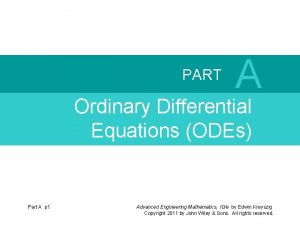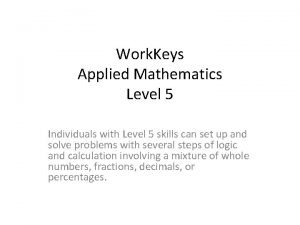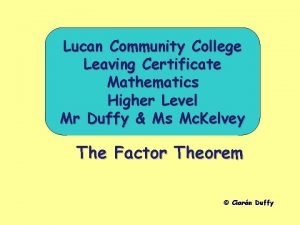Lucan Community College Leaving Certificate Mathematics Higher Level


















- Slides: 18

Lucan Community College Leaving Certificate Mathematics Higher Level Mr Duffy & Ms Mc. Kelvey More Laws of Logarithms © Ciarán Duffy

The Laws of Logs Log laws for Multiplying and Dividing We’ll develop the laws by writing an example with the numbers in index form.

The Laws of Logs A log is just an index, so to write this in index form we need the logs from the calculator. and So,

The Laws of Logs A log is just an index, so to write this in index form we need the logs from the calculator. and So,

The Laws of Logs A log is just an index, so to write this in index form we need the logs from the calculator. and So,

The Laws of Logs A log is just an index, so to write this in index form we need the logs from the calculator. and So, In general,

The Laws of Logs Any positive integer could be used as a base instead of 10, so we get: A similar rule holds for dividing. If the base is missed out, you should assume it could be any base e. g. might be base 10 or any other number.

The Laws of Logs SUMMARY Ø The Laws of Logarithms are: • 1. Multiplication law • 2. Division law • 3. Power law Ø The definition of a logarithm: leads to 4. 5. 6.

The Laws of Logs e. g. 1 Express the following in terms of (a) (b) (c) Solution: (a) ( Law 1 ) ( Law 3 ) (b) (c) Either ( Law 2 ) ( Law 4 ) Or ( Law 3 )

The Laws of Logs e. g. 2 Express in terms of and Solution: We can’t use the power to the front law directly! ( Why not? ) There is no bracket round the ab, so the square ONLY refers to the b. So, ( Law 1 ) ( Law 3 )

The Laws of Logs e. g. 3 Express each of the following as a single logarithm in its simplest form: (a) Solution: (a) (b) This could be simplified to (b)

The Laws of Logs Exercise 1. Express the following in terms of (a) Ans: (a) 2. Express (b) (c) in terms of and Ans: 3. Express the following as a single logarithm in its simplest form: (a) Ans: (a) (b)

The Laws of Logs

The Laws of Logs The following slides contain repeats of information on earlier slides, shown without colour, so that they can be printed and photocopied. For most purposes the slides can be printed as “Handouts” with up to 6 slides per sheet.

The Laws of Logs SUMMARY Ø The Laws of Logarithms are: • 1. Multiplication law • 2. Division law • 3. Power law Ø The definition of a logarithm: leads to 4. 5. 6.

The Laws of Logs e. g. 1 Express the following in terms of (a) (b) (c) Solution: (a) ( Law 1 ) ( Law 3 ) (b) (c) Either ( Law 2 ) ( Law 4 ) Or ( Law 3 )

The Laws of Logs e. g. 2 Express in terms of and Solution: We can’t use the power to the front law directly! ( Why not? ) There is no bracket round the ab, so the square ONLY refers to the b. So, ( Law 1 ) ( Law 3 )

The Laws of Logs e. g. 3 Express each of the following as a single logarithm in its simplest form: (a) Solution: (a) (b) This could be simplified to (b)
 St joseph's college lucan
St joseph's college lucan Society for old lucan
Society for old lucan Leaving certificate history syllabus
Leaving certificate history syllabus Primary leaving certificate
Primary leaving certificate Leaving certificate
Leaving certificate Ahmaths
Ahmaths Higher engineering mathematics
Higher engineering mathematics Complex integration engineering mathematics
Complex integration engineering mathematics Understanding standards advanced higher english
Understanding standards advanced higher english Slide to doc.com
Slide to doc.com Higher certificate in animal welfare
Higher certificate in animal welfare Higher certificate in accounting sciences
Higher certificate in accounting sciences Transition to college mathematics and statistics pdf
Transition to college mathematics and statistics pdf Rowan college of science and mathematics
Rowan college of science and mathematics Community health planning and implementation
Community health planning and implementation Tnnmc website
Tnnmc website College signing day certificate template
College signing day certificate template Cambridge training college britain certificate
Cambridge training college britain certificate Workkeys applied mathematics level 5 answers
Workkeys applied mathematics level 5 answers



































